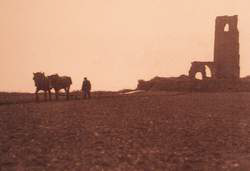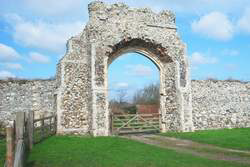Abandoned Communities ..... Dunwich
After 1430 Dunwich continued to fall into the sea. A map of 1587 shows that by that date it was less than half the size it had been in 1200, though the map also indicates that a small amount of development had begun to take place outside the medieval boundary, in particular along Middlegate Street and St James Street.
By the turn of the twentieth century the sea reached the medieval boundary, marked originally by a ditch and rampart known as Palesdyke. The last building within the boundary to fall into the sea was All Saints church. A series of dramatic photographs show the church steadily disappearing between 1887 and 1920. In 1920 all that remained was a single buttress from the tower of the church. It was removed and re-erected in the grounds of St James church, built in 1830 about half a mile inland.
The only surviving medieval buildings, both in ruins, are a section of Greyfriars friary and part of the hospital for people with leprosy. The priory had been constructed in 1297 after its predecessor had been destroyed in the storm of 1286. The leprosy hospital, comprising a chapel and living quarters, was built during the twelfth century. It has survived because it was located well outside the town.
No visit to Dunwich today is complete without spending an hour or two at the museum. While there you are likely to be drawn into conversation with the volunteer museum attendants. They may tell you that the present residents of Dunwich, numbering about 120, differ on some issues but are in full agreement on others. One of the residents is at the forefront of the campaign to close Sizewell B nuclear power station, while others take the view that as the world's oil supplies run out nuclear power will be the only realistic alternative. The issue that produces a rare degree of consensus is the need to ensure that a project favoured by Landmark East is never allowed to go ahead. The intention of the project is to construct full size in situ models of the six churches in Dunwich that collapsed into the sea, using extremely large upright steel rods. The main concern is that if the project is implemented the number of annual visitors to Dunwich would soar into the millions and a motorway would be needed to get them there. There were blank looks when I let the volunteer attendants know that I regard the proposals as utterly magnificent.
An inkling of the splendour of the proposals can be gained at the website of the St Nicholas Centre.
By the turn of the twentieth century the sea reached the medieval boundary, marked originally by a ditch and rampart known as Palesdyke. The last building within the boundary to fall into the sea was All Saints church. A series of dramatic photographs show the church steadily disappearing between 1887 and 1920. In 1920 all that remained was a single buttress from the tower of the church. It was removed and re-
The only surviving medieval buildings, both in ruins, are a section of Greyfriars friary and part of the hospital for people with leprosy. The priory had been constructed in 1297 after its predecessor had been destroyed in the storm of 1286. The leprosy hospital, comprising a chapel and living quarters, was built during the twelfth century. It has survived because it was located well outside the town.
No visit to Dunwich today is complete without spending an hour or two at the museum. While there you are likely to be drawn into conversation with the volunteer museum attendants. They may tell you that the present residents of Dunwich, numbering about 120, differ on some issues but are in full agreement on others. One of the residents is at the forefront of the campaign to close Sizewell B nuclear power station, while others take the view that as the world's oil supplies run out nuclear power will be the only realistic alternative. The issue that produces a rare degree of consensus is the need to ensure that a project favoured by Landmark East is never allowed to go ahead. The intention of the project is to construct full size in situ models of the six churches in Dunwich that collapsed into the sea, using extremely large upright steel rods. The main concern is that if the project is implemented the number of annual visitors to Dunwich would soar into the millions and a motorway would be needed to get them there. There were blank looks when I let the volunteer attendants know that I regard the proposals as utterly magnificent.
Before I left Dunwich I noticed that the house that is third closest to the cliff edge had just been sold. It would be interesting to know whether its new owner is aware that the life expectancy of the house cannot be more than a generation or two.
Six
The church of All Saints
Gateway to Greyfriars priory
The beach at Dunwich
The base of the cliff



